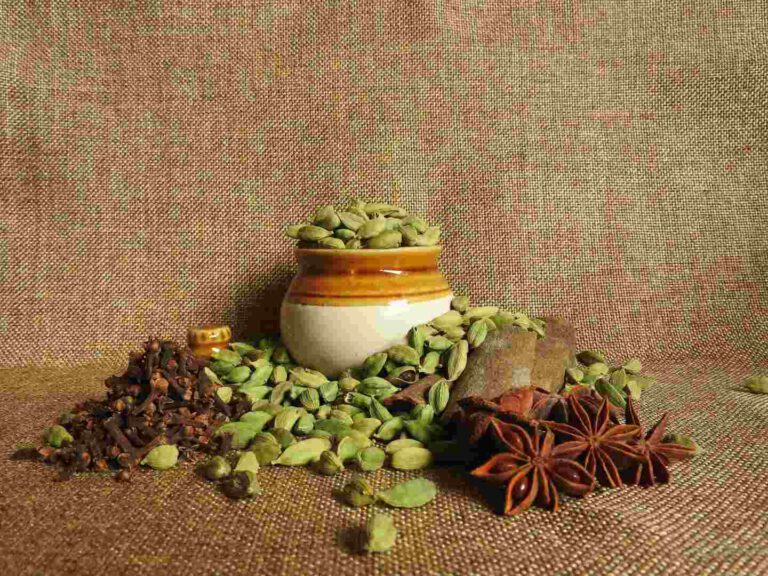Cardamom – properties and uses
Contents:
- Properties of cardamom
- The use of cardamom in the kitchen
- The use of cardamom in cosmetics
- Contraindications to the use of cardamom
Cardamom is a plant belonging to the ginger family and originates from southern India, where it grows naturally in dense tropical forests. It is currently also cultivated in Sri Lanka, the Indochina Peninsula, and China. Cardamom plants produce a spice that is used in both cooking and natural medicine due to its flavor and health-promoting properties. Let's take a look at when and why it's worth using cardamom, how it can be used in the kitchen, and who should be interested in its beneficial effects on our bodies.
Properties of cardamom
Cardamom comes in different forms:
- in the form of ground powder,
- in the form of whole grain products,
- whole - in pods from which the grains are hulled.
The health-promoting properties of this spice have been valued since ancient times.
The Chinese used cardamom for digestive problems, and the Egyptians used cardamom seeds to freshen their breath, among other things. Cardamom first appeared in Europe around the 12th century as a spice rather than a medicine. Today, it is also primarily used in cooking, although it is also said to have natural antiseptic properties and more. Let's examine when it's worth using this exotic spice.
-
Cardamom for digestive problems – Thanks to its essential oils, cardamom can have a diastolic effect on the stomach. It helps combat conditions such as:
- Heartburn,
- flatulence,
- Nausea.
- Supports the body during colds – thanks to its essential oil content, it can be helpful in treating respiratory infections, clearing a stuffy nose, and soothing persistent coughs. You can use cardamom oil for inhalation or brew tea with this spice. Cardamom works:
- Heat,
- antibacterial,
- Antiviral.
The use of cardamom in the kitchen
Cardamom has a characteristic spicy aroma, while its taste is slightly burning and lemony sweet. It pairs perfectly with:
- spicy pastries, especially with gingerbread or carrot cake,
- wintery, warming, sweet black tea with added cinnamon and ginger,
- refreshing green tea with added orange,
- aromatic Turkish coffee with the addition of cinnamon, ginger and vanilla,
- Mulled wine with cinnamon, ginger and cloves,
- meat dishes,
- Meat and vegetarian curry rice,
- Shrimp.
The use of cardamom in cosmetics
Cardamom essential oil is used in cosmetics. It is used in aromatherapy as a relaxing product. It is also used for:
- Massage,
- bathroom
- as an ingredient in perfumes and lotions with a firming effect.
Contraindications to the use of cardamom
Although cardamom is a tasty and valuable spice with many beneficial properties for our health, there are several contraindications to its use. Cardamom is not recommended for the following people:
- suffer from stomach ulcers
- with gastritis
- allergic to spices.
THE PUBLISHER'S CHOICE
Almonds 1 kg BIOGO
- €11,69
€13,75- €11,69
- Unit price
- / per
Walnuts 800 g BIOGO
- €8,65
€10,18- €8,65
- Unit price
- / per
Dried organic mango 400 g BIOGO
- €10,99
- €10,99
- Unit price
- / per
Dried White Mulberries 500 g ORGANIC
- €5,84
€6,87- €5,84
- Unit price
- / per
Dried organic figs 800 g BIOGO
- €30,12
- €30,12
- Unit price
- / per
Unpeeled buckwheat groats 1 kg BIOGO
- €2,81
€3,31- €2,81
- Unit price
- / per
Organic coconut flakes 500 g BIOGO
- €10,07
- €10,07
- Unit price
- / per
Organic oat flakes 600 g BIOGO
- €3,77
- €3,77
- Unit price
- / per
Organic cashew nuts 1 kg BIOGO
- €19,99
- €19,99
- Unit price
- / per
Milk thistle seeds 1 kg BIOGO
- €3,99
- €3,99
- Unit price
- / per









































































































































